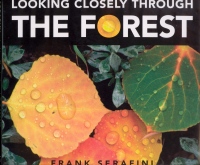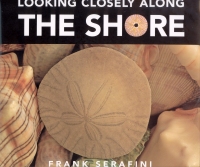| ________________
CM . . .
. Volume XIV Number 21. . . .June 13, 2008
excerpt:
Young readers can explore four different habitats- the forest, the shore, the desert and the garden- in this new series aimed to encourage curiosity and foster an appreciation of nature. Through marvelous close-up photography, Serafini shows readers some detailed characteristics of a variety of plants, rocks and animals. In each case, he poses a question, in poem form, and offers two choices. For example, "Look very closely. What do you see? A whirligig? A butterfly wing? What could it be?" Readers are challenged to examine a portion of a photograph before guessing. On the next page, Serafini reveals the photograph in its entirety and provides a general description of the plant or animal and its habitat. Questions and answers are given on alternate double-page spreads. (Only one very minor criticism of the books is that some of the choices Serafini gives are not of the natural world and, thus, would not normally be found in that environment- for instance, a gummy candy, a bicycle tire or a woolly scarf.) Nine natural objects are highlighted in each of the books. The forest habitat features a sugar maple leaf, a Sego lily, a spotted toadstool, an aspen tree, a yellow-spotted millipede, a turkey tail fungus, frost on a leaf, a pinecone and a green frog. Shore objects include a sand dollar, a gooseneck barnacle, a shore crab, an ochre sea star, a coconut palm tree, a blue mussel, a queen conch shell, a sea anemone and a coastal rock. Both books end with a photograph of the featured habitat. The sharp details and vivid colours of the photographs are sure to appeal to readers. It's just a shame that there are only nine objects in each book for readers will surely want more.
Highly Recommended. Gail Hamilton is a teacher-librarian in Winnipeg, MB.
To comment
on this title or this review, send mail to cm@umanitoba.ca.
Copyright © the Manitoba Library Association. Reproduction for personal
use is permitted only if this copyright notice is maintained. Any
other reproduction is prohibited without permission.
NEXT REVIEW |
TABLE OF CONTENTS FOR THIS ISSUE
- June 13, 2008.
AUTHORS |
TITLES |
MEDIA REVIEWS |
PROFILES |
BACK ISSUES |
SEARCH |
CMARCHIVE |
HOME |

